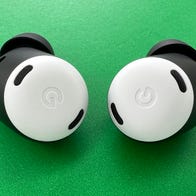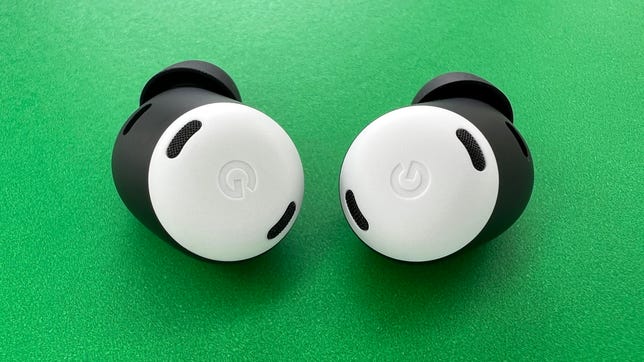Google Pixel Buds Pro Review: Better Fit, Better Sound
While the new Pixel Buds Pro offer improved sound and top-notch noise-canceling, their killer feature may be their fit.
 Why You Can Trust CNET
Why You Can Trust CNET

Pros
- Tapered design allows for secure, discreet, comfortable fit
- Very good sound and impressive noise canceling
- Natural-sounding transparency mode
- Good voice-calling performance
- Good battery life
- Hands-free Google Assistant for Android users
Cons
- No support for aptX or LDAC audio codecs for Android users
- A few features not available for Apple users
- Spatial audio feature not available at launch
The $200 (£179, AU$299) Pixel Buds Pro are Google's first earbuds to feature active noise canceling. While it's nice that they finally have a feature that a lot of true-wireless earbuds have had for a while, what ultimately sets the Pixel Buds Pro apart and makes them strongly worth considering -- particularly for Android users -- is their distinct design and winning fit. That helps enhance their strong performance on both the sound quality and noise-canceling fronts.
The first thing you'll notice about the Pixel Buds Pro is that they're not shaped like your typical earbuds or Google's earlier Pixel Buds 2 and Pixel Buds A-Series, which stripped out some features to get to a more affordable sub-$100 price tag. They're a bit flatter and more elongated.
With that shape, the buds nestle nicely in the conchas of your ears -- or at least they did for me -- allowing you to get a tight seal and secure fit (and they don't stick out of your ears much). Each bud weighs 6.2 grams, so they're reasonably lightweight as earbuds go, coming in about a gram more than an AirPods Pro bud. By comparison, the Pixel Buds A-Series weigh in at 5.1 grams per bud, while Sony's LinkBuds S tip the scales at 4.8 grams.
Read more: Best Wireless Earbuds for 2022
Gone is the integrated wing tip or sport fin found in the Pixel Buds 2 and Pixel Buds A-Series. These buds rely entirely on their shape -- and the shape of their ear tips (three sizes are included and there's an ear tip seal check in the app) -- to get an ideal fit that keeps them from falling out of your ears even while tilting your head at a 90-degree angle to the ground. I personally like wing tips and gave a CNET Editors' Choice award to the Beats Fit Pro earbuds (which have integrated fins), so I was a bit skeptical that these would fit my ears better than the Pixel Buds A-Series buds. But they did, and I had no trouble running with them.
That said, the usual caveats apply for noise-isolating earbuds: I can't guarantee these will fit everybody's ears equally well, and some people may not be able to get a secure fit or their ears may be too small to accommodate the buds. Also, in some cases, they may fit some ears so well that you may get an occluded sensation when the noise canceling is turned on.
To that end, Google has included something called "active in-ear pressure relief," which is similar to Apple's vent system designed to equalize pressure with its AirPods Pro. While it does seem to help relieve some pressure, I did find myself using the transparency mode to open the earbuds up to the outside world a little more often than I usually do. (You tap and hold the touch control on either earbud to toggle between noise canceling and transparency modes.) It's one of the better transparency modes I've used and sounds quite natural with only very slight sound amplification. It's almost there with the AirPods Pro's transparency mode, which is top-notch.
The Pixel Buds Pro are available in four colors: coral (reddish-pink), lemongrass (yellow), fog (white) and charcoal (black).
The charging case, which charges wirelessly and via USB-C, looks similar to the Pixel Buds A-Series' case but is about 10% to 15% bigger, though it's still compact. Battery life is good: It's rated at up to seven hours at moderate volume levels with noise canceling on and at up to 11 hours with noise canceling off. The case will provide just under two additional full charges, and is IPX2 splash-resistant while the buds are IPX4 splash-proof. Google says a five-minute charge delivers up to an hour of listening time with noise canceling on.
Along with the aforementioned touch controls -- yes, they're responsive and easy to operate -- you get an ear-detection sensor that automatically pauses and resumes your audio when you take the buds in and out of your ears. Additionally, there's a motion-detecting accelerometer and a gyroscope that may come into play when Google adds a spatial audio virtual surround feature later this year for movies and TV shows. I asked Google reps whether that feature would only be available for Pixel devices and which models. They simply replied, "We'll have more to share on Spatial Audio later this year," so we're all waiting for more details on that front.
The Pixel Buds Pro (left) is larger than the Pixel Buds A-Series (right).
Equipped with Bluetooth 5.0, the Pixel Buds Pro don't appear to have any of the connectivity issues (dropouts) that some users encountered with the earlier Pixel Buds 2 and Google managed to ameliorate but not completely eliminate with firmware upgrades. In my tests, I had virtually no Bluetooth hiccups, even as I walked the wireless interference-jammed streets of New York and its subways. So hopefully Google has moved passed any connectivity issues that it's had with its true-wireless buds. (The A-Series are mostly free of dropouts although a small number users complained about issues.) That said, you should expect Google to push out the occasional firmware update to quash any bugs and tweak performance and eventually add its Spatial Audio feature, and perhaps other new features.
The Pixel Buds Pro also support multipoint Bluetooth pairing, allowing you to connect the buds to two devices simultaneously, including Apple iOS devices, as well as Macs and Windows PCs. You have to activate "Use multipoint" in the settings on an Android device for the feature to work. On top of that, Google has enabled a new automatic switching feature between Android devices that builds on Google Fast pair technology and works similarly Apple's auto switching for Apple devices. Some people find the feature irritating, but Google has made it easy to "switch the audio back to the original device you were listening on in a single tap."
The buds really didn't stick out of my ears much, but if you have smaller ears, they may stick out a bit more.
The one thing missing is support for Qualcomm's aptX or Sony's LDAC audio codecs for Bluetooth streaming. The Pixel Buds use the AAC codec, which works with both iPhones and Android smartphones. Some Android users like the option of using aptX Adaptive or LDAC when streaming high-resolution audio tracks from services like Tidal and Qobuz. In theory, you can get slightly better sound using those codecs with the right audio sources.
Some people were disappointed that the Pixel Buds A-Series left off the swipe for volume "gesture" control feature which was present on the Pixel Buds 2; you run your finger across the bud to adjust volume. I'm happy to report that -- yes! -- the Pixel Buds Pro have gesture controls for volume. Additionally, you can use Google Assistant to control volume by simply saying, "Hey, Google," then telling it to raise or lower volume. For Android users, Google Assistant is always on, listening for your voice commands like Siri does with the AirPods, so you don't have to tap a button to access it unless you turn off the feature.
Along with a couple of Android smartphones, I used these buds with an iPhone 13 Pro, and they worked fine, but you lose a few features: There's no hands-free Google Assistant and it seems pretty safe to assume that the upcoming spatial audio feature won't work with Apple devices. It's worth noting that both the Volume EQ feature that automatically "enhances bass and treble frequencies at lower volumes" and ear-detection sensors will only work with iPhones if you first enable them using an Android device (they are not set to on as a default).
At launch, Google mentioned something about a "full 5-band EQ that lets you customize the sound to your preferences." But like spatial audio, that feature won't be available until later this year. Until it appears, turning on the Volume EQ feature is the only thing that will impact the signature sound profile. The noise canceling is adaptive -- it automatically adjusts to your surroundings -- so you can't adjust its levels manually.
Richer sound with impressive noise canceling
The Pixel Buds Pro are bigger buds (volume-wise) than the Pixel Buds A-Series and feature different drivers. Interestingly, the drivers in the Pixel Buds Pro are smaller than the drivers in the Pixel Buds A-Series (11 versus 12 mm), but Google describes the Pixel Buds Pro drivers as "custom-designed" while the Pixel Buds A-Series don't get that designation (for whatever that's worth).
Either way, the Pixel Buds Pro sound better, with smoother, fuller sound that offers deeper bass and improved clarity along with a wider, more open soundstage (they also sound a little more natural). I also felt the buds were able to resolve more complicated music tracks and bring out more detail without getting mushy or sounding slightly distorted at higher volumes. The quality of the sound is just a level up, with more depth and nuance to it. And in case you're wondering, they do sound better than the AirPods Pro.
One of the tracks I spent some time listening to for my comparisons is The Handsome Family's Far From Any Road track. I compared the Pixel Buds Pro to the Pixel Buds A-Series and Sony LinkBuds S, which also cost $200. The LinkBuds S are in the same realm, but if you get a really good fit with the Pixel Buds Pro, you get a touch more bass and I liked their tonal balance a tad better. But the LinkBuds S are lightweight and also fit my ears well -- they're quite comfortable -- so it's hard to declare the Pixel Buds Pro the clear winner.
As I indicated in the intro, the way a set of earbuds fit and how tight a seal you get has the ability to enhance both the sound quality and noise canceling. Google describes the Pixel Buds Pro as having "active noise canceling with Silent Seal" that automatically adapts to the contours of your ears and is powered by a custom Google processor and algorithms that constantly analyze "external sound and cancels it, making background noise disappear." The Pixel Buds A-Series fit my ears well, but I felt like I got an even tighter seal with the Pixel Buds Pro, and I had no doubt I was getting optimal performance -- for both sound quality and noise canceling.
The noise canceling was top-notch. I have a noisy HVAC unit in my apartment and the Pixel Buds Pro did as good a job as Sony's flagship WF-1000XM4 earbuds muffling its sound -- and those Sony buds have excellent noise canceling. The Pixel Buds Pro also did a nice job in the streets of New York and on its subways, where you have a cacophony of noise in more frequency ranges, including voices in the higher frequencies. If you get a tight seal, most people should be quite impressed with the Pixel Buds Pro's noise-canceling capabilities.
They also performed well as a headset for making calls. Each earbuds has three microphones with wind-blocking mesh covers and a voice accelerometer that detects when you're speaking. According to the callers I spoke with, they didn't completely block out external noise when I was testing them in the streets of New York, but they did reduce it while allowing my voice to come through clearly. They are not quite elite in the voice-calling department, but they are in the upper tier.
Pixel Buds Pro: Final thoughts
While the Pixel Buds Pro are fairly pricey at $200, they measure up well against other earbuds in this price range, including the Sony LinkBuds S and Beats Fit Pro, and offer excellent performance overall. As I said, the key for me was how well they fit my ears and how their design is just a little different from that of a lot of earbuds out there right now. While the Pixel Buds Pro may not be perfect for everybody's ears, they seem like they'll be a good fit for a lot of folks.
Alas, while they work just fine with iPhones and other Apple devices, they're clearly more geared toward Android users and well worth considering if you have an Android model as your primary smartphone.
Mobile Guides
- Best Wireless Earbuds
- Best Noise Canceling Headphones
- Best Headphones
- Best Over Ear Headphones
- Best Wireless Earbuds and Headphones for Making Calls
- Best Headphones for Work at Home
- Best Noise Canceling Wireless Earbuds
- Best Sounding Wireless Earbuds
- Best Cheap Wireless Earbuds
- Best Wireless Headphones


